Rizzuto Gallery is hosting the solo show “Narrativa” by Palermo artist Francesco De Grandi, a leading name in contemporary painting and professor of Painting at the Academy of Fine Arts in Palermo. The exhibition – which can be visited until next 24th February – proposes an articulated itinerary from which part of a metaphorical DNA, belonging to an epic and choral genealogy with myths and archetypes of Western history, emerges. From the ancient biblical, mythological and legendary tradition De Grandi’s pictorial narrative comes, reveals and testifies, preserves and celebrates, in a hieratic and solemn manner, sacred and brutal stories, such as the work that recounts the flaying of the apostle Saint Bartholomew. Moreover, his paintings propose visions of trees, gazes, mythological references of blood and flesh without providing any judgement. In this aspect, De Grandi’s painting is largely unified and leaves no room for any Manichean or moralistic reasoning, as it is flesh and soul at the same time, skin and earth, dream and reality, pain and joy, apnoea and breath.
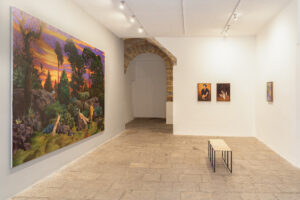
Francesco De Grandi, Narrativa, exhibition view, Rizzuto Gallery, Palermo, 2023. Courtesy the artist and Rizzuto Gallery
Nilla Zaira D’Urso: Where does the choice of titling your exhibition “Narrative” come from?
Francesco De Grandi: There are two reasons: the first is linked to the fact that I believe in the use of narrative painting, which, until recently, was almost viewed with annoyance because the idea of a tale was a kind of taboo from a pictorial point of view. Hence, within the intellectual-artistic world, it has been believed that painting should no longer represent as the pictorial idea of a visual narrative – from the time of day to the type of light, from the textures of a dress and everything else – was regarded with negative meaning. This thinking, specifically, was the first motivation that came to my mind when I chose the title, because for me “narrative” does not have a negative meaning. The second one is related to the fact that all the paintings on view belong to narratives. Moreover, since there are mythological, evangelical and legendary narratives in the exhibition, the idea of using a term that encompasses these two aspects convinced me and I came up with the choice of such a title. Finally, there is also another reference, linked to the contemporary narratives, where the storytelling through images is among the least real things that exist, painting on the other hand keeps the peculiarity of being real, present and true despite telling imaginary worlds.
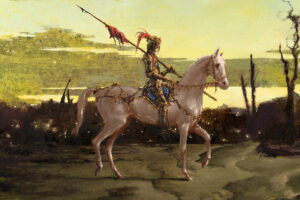
Francesco De Grandi, Cappa e spada, 2023. Oil on canvas, 80 x 120 cm. Courtesy the artist and Rizzuto Gallery
In presenting the exhibition, you stated that «painting still retains a form of honesty», what do you mean with the word “honesty”?
I believe that when you look at a painting, it is as if the person who painted it, in some way, is totally naked and cannot hide from the viewer’s gaze. This thought is very powerful and present in any work. It is no coincidence that many analysts, especially child analysts, use the sign as an instrument of investigation, as drawing has a direct channel to the unconscious, to intimacy and to what we really keep as hidden as possible. With painting, however, this veil disappears, and everything emerges. This is quite nail-biting and, not surprisingly, I often explain this to my students as they experience judgement with great anxiety and, especially at the beginning, they do not understand why they feel it so strongly. I also explain that what they do has to deal with their own identity and depth, it is thus necessary to get used to often tugging at our most sensitive strings.
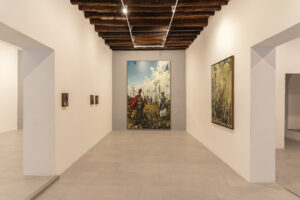
Francesco De Grandi, Narrativa, exhibition view, Rizzuto Gallery, Palermo, 2023. Courtesy the artist and Rizzuto Gallery
A surgical attitude is evident in your paintings, works devoid of any form of judgement. How can you be so objective and neutral in front of gory scenes?
I perceive my work in a split way: I could say that I am simultaneously very empathetic, but also lucid and controlled. I remember that every artist, when they have to create a work, they use a certain technique and therefore have to keep control of it while remaining lucid, even if at the same time they are experiencing a strong emotion that they want to convey almost at the risk of losing themselves. I think this applies to all artists: a raw emotion arrives, then you govern it, and here you need to be present to yourself with a level of awareness with which you can proceed to work. Awareness then needs to be trained and can also become a way of life. To latch onto your simile, I would say that I am like a surgeon entering the operating room, aware and detached when I paint. However, I believe there is also a therapeutic reasoning in this detachment. Honestly, when I am working on a painting, my only problem is resolving the technical expressive issues that go hand in hand and this requires a presence, an awareness.
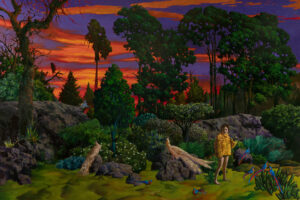
Francesco De Grandi, Medea nel giardino del regno di Colchide, 2023. Oil on canvas, 230 x 340 cm. Courtesy the artist and Rizzuto Gallery
On the subject of painting as an instrument of knowledge, if Leonardo used drawing to investigate reality, you use the medium of painting to investigate and learn about the world from the archetypes and bring them into the real. I am curious to know what you think about the “real” of our world?
I think ours is a very complex world and this complexity means unravelling the skein, playing the game. I do not believe in slogans, in simplifications, on the contrary, I always try to find the complexity because it characterises our existence and, above all, it imposes a look. Perhaps being a painter is the result of this gaze because painting has its own times, which are not those of the contemporary world, they are times of reflection, meditation, technical waits. This is why I say that painting is an instrument of investigation that succeeds in rendering the complexity of things, in investigating their facets. We live in extremely complex times, which must be unraveled and understood in their complexity and not reduced into slogans or simplifications.
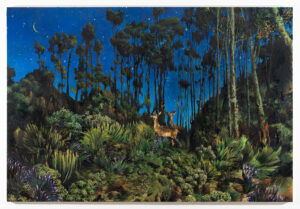
Francesco De Grandi, Il sogno di Placido, 2023. Oil on canvas, 170 x 250 cm. Courtesy the artist and Rizzuto Gallery
You also stated that «myths, legends, novellas have come down to us through testimony and storytelling. That they have crossed time and space and are still urgent and capable of creating worlds». What is “urgency” for you?
Urgency is to make one’s existence a way to become aware of one’s place in the world: to identify and consequently trace the individual urgencies that I believe are inherent in each of us. These urgencies are a kind of gift, if we want to put it on a spiritual level. They are a dowry and a task to be associated with a sense of divinity or sacredness. This trousseau is the shape of our body, and the urgency is that thing that allows us to identify this other – the sacred precisely – and indulge it, cultivate it. For example, in Western Christian culture there is the very powerful archetype of the “gift” described in Genesis: the giving of a wonderful garden and telling the man to name everything and govern it. We need to go to the root of things and intercept this gift because if we do not, it would be like betraying ourselves and not identifying ourselves. The urgency becomes “that flash” in which one identifies one’s task and the gift is the completion of it. For example, I cannot remember a moment when I decided to start painting, I always knew. However, it has been difficult to identify myself and this has been the reason for a lot of work, suffering, wrong paths, attempts, failures. Another example is when I am working on a painting and I know perfectly well that I could lose it at any moment, as if it were on the brink of failure. Right now, I am working on a painting and I realised that I have made a mistake and that I have to rethink certain steps. I made this point in order to say that my research has not found completion, but it is always in progress, knowing also that I am working alongside the potential loss of the painting itself.
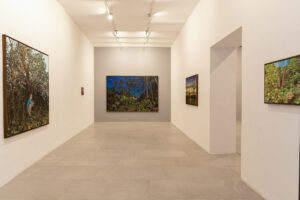
Francesco De Grandi, Narrativa, exhibition view, Rizzuto Gallery, Palermo, 2023. Courtesy the artist and Rizzuto Gallery
Speaking of “loss”, let us address your relationship with the word “death”.
First of all, I would like to point out that I would be lying if I spoke of a serene attitude towards death. It is the carrion that hovers over all our existences: the “big question” that we all ask ourselves all the time and, even if we do not ask it consciously, it is still “what” drives us to search. In this sense, painting is an excellent vehicle for me, allowing me to investigate a number of themes, mostly with a sacred background linked to Western culture – although the sacred has been banished from contemporary art over the last thirty years or more. Indeed, in painting the sacred has been a great taboo, but theatre and cinema have tackled it, just think of Pasolini, whereas in the visual arts it is still a virgin ground.
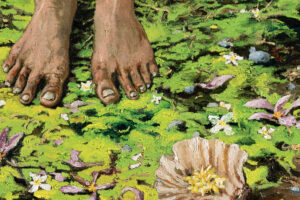
Francesco De Grandi, I piedi di Rosalia, 2023. Oil on canvas, 45 x 60 cm. Courtesy the artist and Rizzuto Gallery
Regarding the painting in the exhibition linked to the story of the apostle Saint Bartholomew, where does the choice to depict the scene in which he is skinned by pagans come from?
Two reasons: the first is because Saint Bartholomew is the patron saint of Ustica, where I have my home and where I have spent the happiest afternoons of my life, and he is celebrated every 25th August. The second reason is related to the fact that St. Bartholomew – precisely because of his martyrdom – has been iconographically represented by many other artists. And then, ever since I was a little boy, looking at all these medieval representations of martyrs, St. Bartholomew has always struck my imagination.
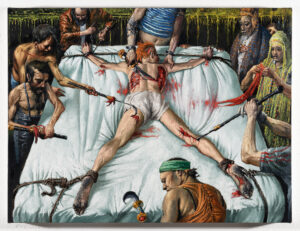
Francesco De Grandi, Martirio di San Bartolomeo Apostolo, 2023. Oil on canvas, 45 x 60 cm. Courtesy the artist and Rizzuto Gallery
In closing, I ask you both for an ending reflection and to make an association between a musical rhythm and your painting.
I am reminded of a reflection on the value of utopia: we must be able to cultivate utopia, if we do not cultivate it we do not move, without it we would never have evolved. I am well aware that philosophically, as an artist, I can conceive such reasoning and raise an ever-present form of judgement on the “victim and executioner” condition. Personally, I observe this phenomenon as it is and, at the same time, I realise that society is inexorably moving forward, but injustice always makes me angry. It is no coincidence that in my work there is a stance on certain issues. In the painting on display “Succubi e supplizi” (Dominated and torture) the play of “power” that changes its tunic and always acts in one way is represented, and those who pay the consequences are always the same ones: the pure, the poor. Here too, paraphrasing Italo Calvino’s “The Nonexistent Knight”, one can look at the painting as if it were a meta-narrative, totally imaginary, but speaking about us. Or, “Il signore delle mosche” (Lord of the flies) is another work that refers to both William Golding’s novel and the film by director Peter Brook. But even in this case, I bring back that ambivalent and powerful atrocity, narrated by Golding, which has young boys as protagonists. Finally, to answer your question, regarding music, if we stay on the classical, I associate my painting with the composition “Suite scita” by Sergei Sergeevič Prokof’ev because I believe that my painting is very Russian and linked to composers such as Bartók and Stravinsky despite the latter being too intellectual. But I recognise myself in the musical experience of the 20th century where this mixture of musical tradition on the one hand and openness to a new way of making music on the other was very present.
Nilla Zaira D’Urso
Info:
Francesco De Grandi, Narrativa
12/12/2023 – 24/02/2024
Rizzuto Gallery
via Maletto 5, 90133 Palermo
rizzutogallery.com
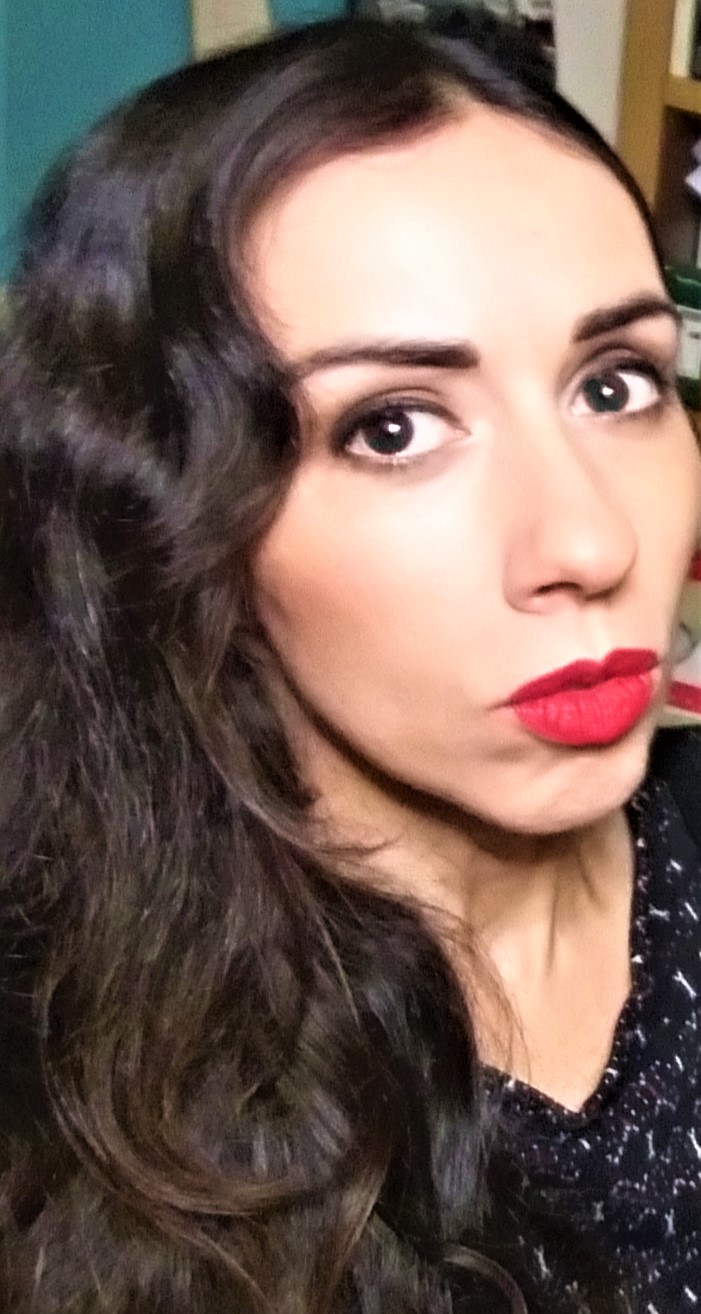
Through art she feels the need to get closer to nature, deciding to create an artistic residence on Etna as a “refuge for contemporary art” for artists and scholars. Thus was born Nake artistic residence. She won the Responsible Etna Award 2015. In 2017, she was invited to the Sala Zuccari, Senate of the Republic, as an art critic. She writes for Italian and foreign artists. Curator of the first Museum of Contemporary Art of Etna and of the “Contemporary Etna” project.






NO COMMENT